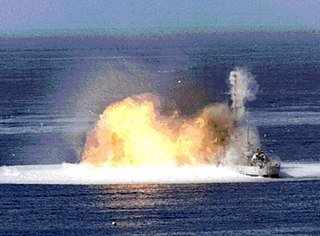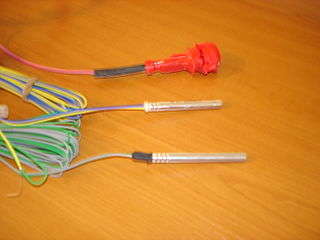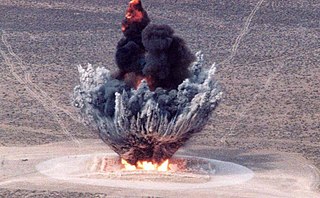
An explosive is a reactive substance that contains a great amount of potential energy that can produce an explosion if released suddenly, usually accompanied by the production of light, heat, sound, and pressure. An explosive charge is a measured quantity of explosive material, which may either be composed solely of one ingredient or be a mixture containing at least two substances.

Trinitrotoluene, more commonly known as TNT, more specifically 2,4,6-trinitrotoluene, and by its preferred IUPAC name 2-methyl-1,3,5-trinitrobenzene, is a chemical compound with the formula C6H2(NO2)3CH3. TNT is occasionally used as a reagent in chemical synthesis, but it is best known as an explosive material with convenient handling properties. The explosive yield of TNT is considered to be the standard comparative convention of bombs and asteroid impacts. In chemistry, TNT is used to generate charge transfer salts.

A thermobaric weapon, also called an aerosol bomb, or a vacuum bomb, is a type of explosive that uses oxygen from the surrounding air to generate a high-temperature explosion. The fuel–air explosive is one of the best-known types of thermobaric weapons.

A shaped charge is an explosive charge shaped to focus the effect of the explosive's energy. Different types of shaped charges are used for various purposes such as cutting and forming metal, initiating nuclear weapons, penetrating armor, or perforating wells in the oil and gas industry.

Pentaerythritol tetranitrate (PETN), also known as PENT, PENTA, TEN, corpent, or penthrite, is an explosive material. It is the nitrate ester of pentaerythritol, and is structurally very similar to nitroglycerin. Penta refers to the five carbon atoms of the neopentane skeleton. PETN is a very powerful explosive material with a relative effectiveness factor of 1.66. When mixed with a plasticizer, PETN forms a plastic explosive. Along with RDX it is the main ingredient of Semtex and C4.

A bomb is an explosive weapon that uses the exothermic reaction of an explosive material to provide an extremely sudden and violent release of energy. Detonations inflict damage principally through ground- and atmosphere-transmitted mechanical stress, the impact and penetration of pressure-driven projectiles, pressure damage, and explosion-generated effects. Bombs have been utilized since the 11th century starting in East Asia.

A detonator, sometimes called a blasting cap in the US, is a small sensitive device used to detonate a larger, more powerful but relatively insensitive secondary explosive of an explosive device used in commercial mining, excavation, demolition, etc.

C-4 or Composition C-4 is a common variety of the plastic explosive family known as Composition C, which uses RDX as its explosive agent. C-4 is composed of explosives, plastic binder, plasticizer to make it malleable, and usually a marker or odorizing taggant chemical. C-4 has a texture similar to modelling clay and can be molded into any desired shape. C-4 is relatively insensitive and can be detonated only by the shock wave from a detonator or blasting cap.

A depth charge is an anti-submarine warfare (ASW) weapon. It is intended to destroy a submarine by being dropped into the water nearby and detonating, subjecting the target to a powerful and destructive hydraulic shock. Most depth charges use high explosive charges and a fuze set to detonate the charge, typically at a specific depth. Depth charges can be dropped by ships, patrol aircraft, and helicopters.

ANFO ( AN-foh) (or AN/FO, for ammonium nitrate/fuel oil) is a widely used bulk industrial explosive. It consists of 94% porous prilled ammonium nitrate (NH4NO3) (AN), which acts as the oxidizing agent and absorbent for the fuel, and 6% number 2 fuel oil (FO). The use of ANFO originated in the 1950s.

The effects of a nuclear explosion on its immediate vicinity are typically much more destructive and multifaceted than those caused by conventional explosives. In most cases, the energy released from a nuclear weapon detonated within the lower atmosphere can be approximately divided into four basic categories:
Polymer-bonded explosives, also called PBX or plastic-bonded explosives, are explosive materials in which explosive powder is bound together in a matrix using small quantities of a synthetic polymer. PBXs are normally used for explosive materials that are not easily melted into a casting, or are otherwise difficult to form.

The exploding-bridgewire detonator is a type of detonator used to initiate the detonation reaction in explosive materials, similar to a blasting cap because it is fired using an electric current. EBWs use a different physical mechanism than blasting caps, using more electricity delivered much more rapidly, and explode in a much more precise timing after the electric current is applied, by the process of exploding wire method. This has led to their common use in nuclear weapons.
A triggering sequence, also called an explosive train or a firing train, is a sequence of events that culminates in the detonation of explosives. For safety reasons, most widely used high explosives are difficult to detonate. A primary explosive of higher sensitivity is used to trigger a uniform and predictable detonation of the main body of the explosive. Although the primary explosive itself is generally a more sensitive and expensive compound, it is only used in small quantities and in relatively safely packaged forms. By design there are low explosives and high explosives made such that the low explosives are highly sensitive and high explosives are comparatively insensitive. This not only affords inherent safety to the usage of explosives during handling and transport, but also necessitates an explosive triggering sequence or explosive train. The explosive triggering sequence or the explosive train essentially consists of an 'initiator', an 'intermediary' and the 'high explosive'.
Shock sensitivity is a comparative measure of the sensitivity to sudden compression of an explosive chemical compound. Determination of the shock sensitivity of a material intended for practical use is one important aspect of safety testing of explosives. A variety of tests and indices are in use, of which one of the more common is the Rotter Impact Test with results expressed as FoI At least four other impact tests are in common use, while various "gap tests" are used to measure sensitivity to blast shock.
In fluid dynamics, a blast wave is the increased pressure and flow resulting from the deposition of a large amount of energy in a small, very localised volume. The flow field can be approximated as a lead shock wave, followed by a self-similar subsonic flow field. In simpler terms, a blast wave is an area of pressure expanding supersonically outward from an explosive core. It has a leading shock front of compressed gases. The blast wave is followed by a blast wind of negative gauge pressure, which sucks items back in towards the center. The blast wave is harmful especially when one is very close to the center or at a location of constructive interference. High explosives that detonate generate blast waves.
An underwater explosion is a chemical or nuclear explosion that occurs under the surface of a body of water. While useful in anti-ship and submarine warfare, underwater bombs are not as effective against coastal facilities.

Operation Sailor Hat was a series of explosives effects tests, conducted by the United States Navy Bureau of Ships under the sponsorship of the Defense Atomic Support Agency. The tests consisted of two underwater explosions at San Clemente Island, California in 1964 and three surface explosions at Kahoʻolawe, Hawaii in 1965. They were non-nuclear tests employing large quantities of conventional explosives to determine the effects of a nuclear weapon blast on naval vessels, and the first major test of this kind since Operation Crossroads in July 1946.

An explosion is a rapid expansion in volume of a given amount of matter associated with an extreme outward release of energy, usually with the generation of high temperatures and release of high-pressure gases. Explosions may also be generated by a slower expansion that would normally not be forceful, but is not allowed to expand, so that when whatever is containing the expansion is broken by the pressure that builds as the matter inside tries to expand, the matter expands forcefully. An example of this is a volcanic eruption created by the expansion of magma in a magma chamber as it rises to the surface. Supersonic explosions created by high explosives are known as detonations and travel through shock waves. Subsonic explosions are created by low explosives through a slower combustion process known as deflagration.
In military munitions, a fuze is the part of the device that initiates function. In some applications, such as torpedoes, a fuze may be identified by function as the exploder. The relative complexity of even the earliest fuze designs can be seen in cutaway diagrams.













